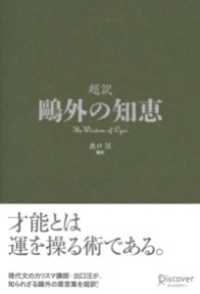- ホーム
- > 洋書
- > 英文書
- > Science / Mathematics
Full Description
The Advanced Study Institute provided an opportunity for researchers in universities, industry and National and International Laboratories, from the disciplines ofmaterials science, physics, chemistry and engineering to meet together in an assessment of the impact of electron and scanning probe microscopy on advanced material research. Since these researchers have traditionally relied upon different approaches, due to their different scientific background, to advanced materials problem solving, presentations and discussion within the Institute sessions were initially devoted to developing a set ofmutually understood basic concepts, inherently related to different techniques ofcharacterization by microscopy and spectroscopy. Particular importance was placed on Electron Energy Loss Spectroscopy (EELS), Scanning Probe Microscopy (SPM), High Resolution Transmission and Scanning Electron Microscopy (HRTEM, HRSTEM) and Environmental Scanning Electron Microscopy (ESEM). It was recognized that the electronic structure derived directly from EELS analysis as well as from atomic positions in HRTEM or High Angle Annular Dark Field STEM can be used to understand the macroscopic behaviour of materials. The emphasis, however, was upon the analysis of the electronic band structure of grain boundaries, fundamental for the understanding of macroscopic quantities such as strength, cohesion, plasticity, etc.
Contents
The impact of electron microscopy on materials research.- Microstructural design and tayloring of advanced materials.- Nanostructured materials.- Characterization of heterophase transformation interfaces by high-resolution transmission electron microscope techniques.- High resolution scanning electron microscopy observations of nano-ceramics.- Metal-ceramic interfaces studied with high resolution transmission electron microscopy.- Z-contrast scanning transmission electron microscopy.- Electron energy loss spectrometry in the electron microscope - Part 1: Introduction.- Electron energy loss spectrometry in the electron microscope - Part 2: EELS in the context of solid state spectroscopies.- Electron energy loss spectrometry in the electron microscope - Part 3: Interfaces and localised spectrometry.- EELS near edge structures. Application to intermetallic alloys and other materials.- Surface chemistiy and microstructure analysis of novel technological materials.- Convergent beam electron diffraction.- New developments in scanning probe microscopy.- Low-energy scanning electron microscope for nanolithography.- Application of low voltage Scanning Electron Microscopy and energy dispersive x-ray spectroscopy.- Environmental SEM and related applications. History of the environmental SEM and basic design concepts.- Environmental SEM and related applications. Gas interactions and gaseous amplification.- Environmental SEM and related applications. Applications.- ESEM image contrast and applications to wet organic materials.- Advanced electron and scanning probe microscopy on dental and medical materials research.- Correlative microscopy and probing in materials science.- Epilogue.








